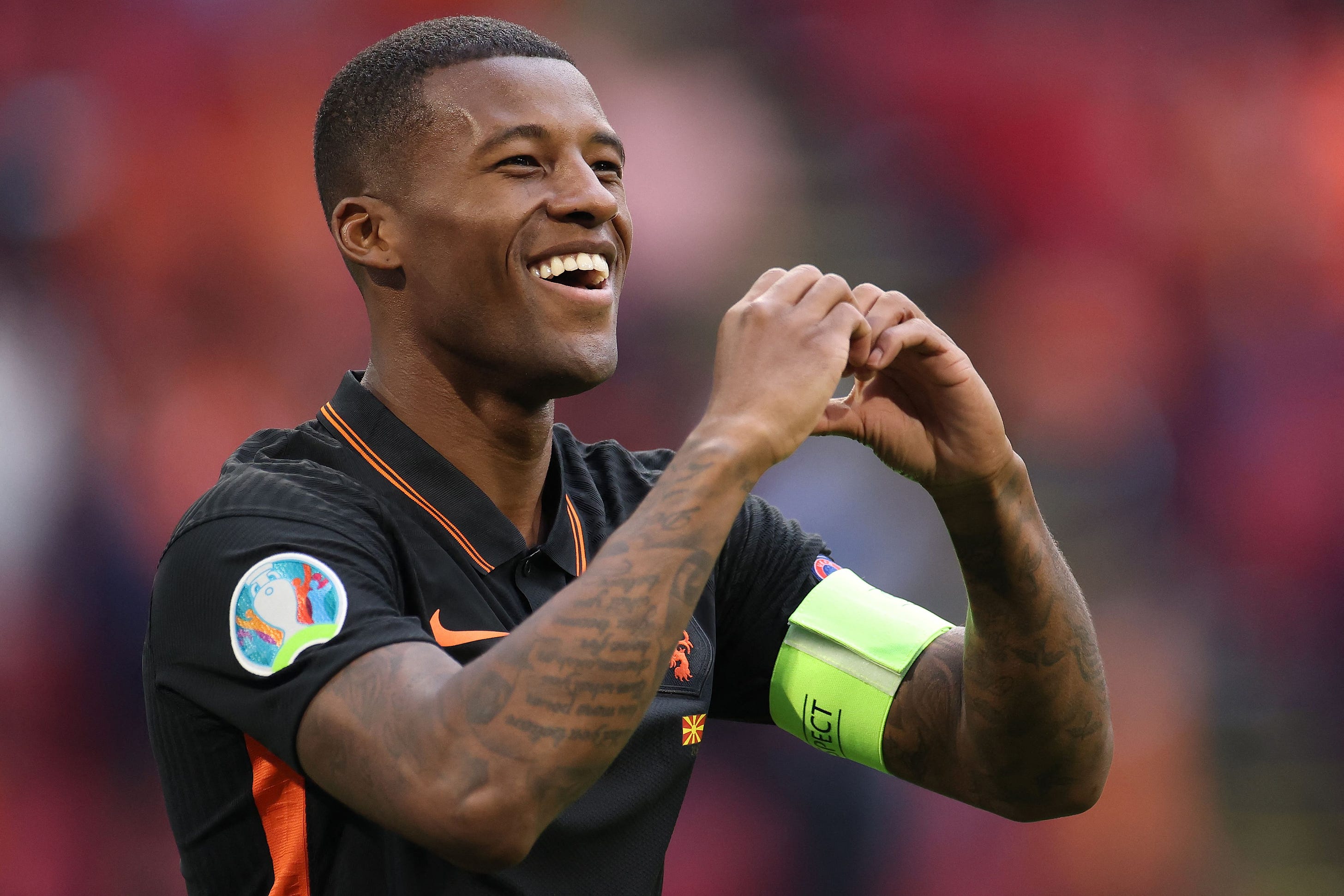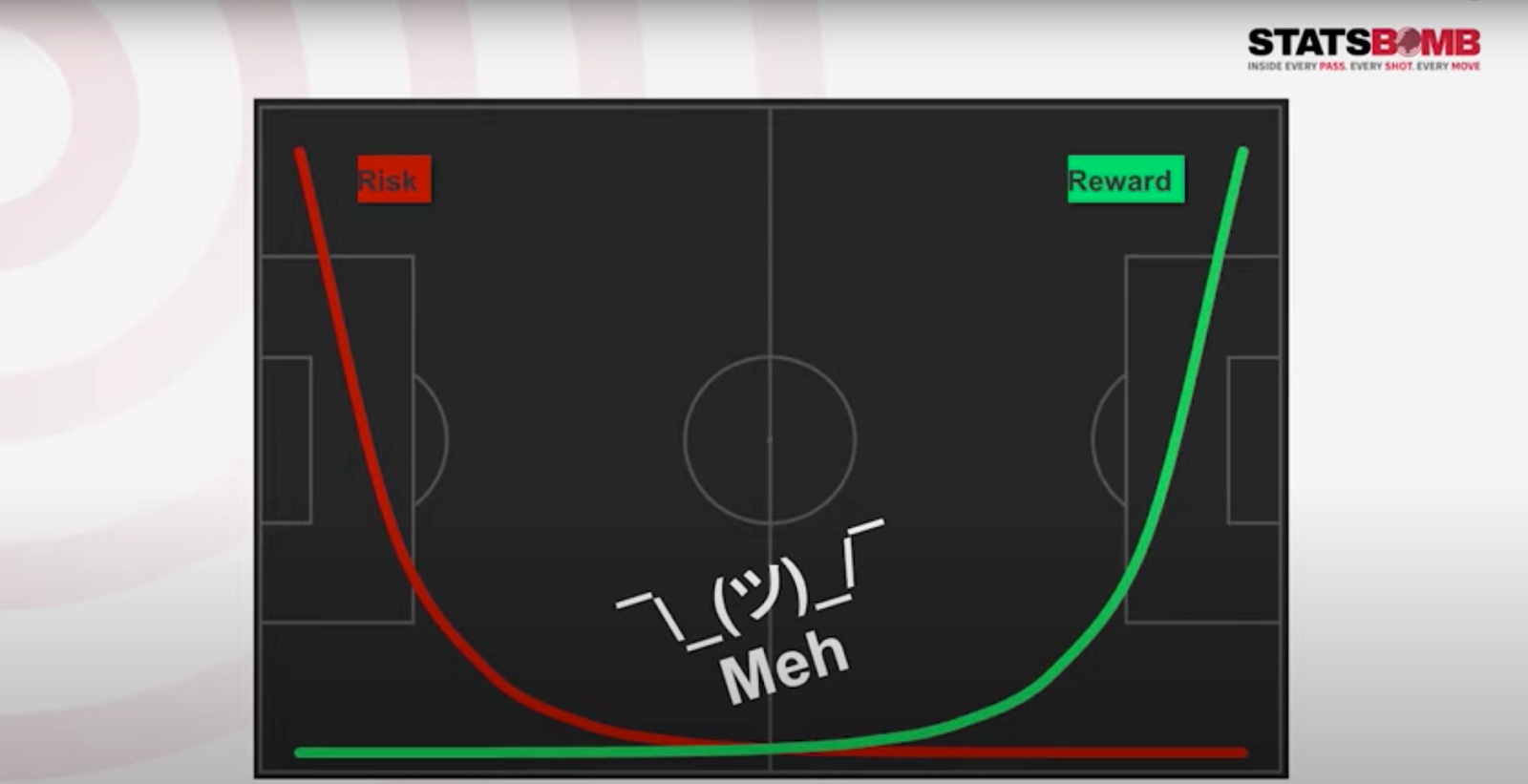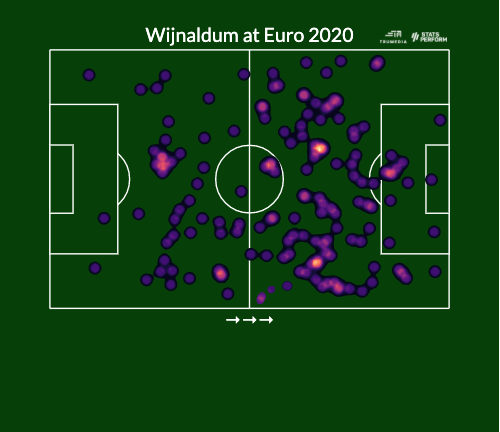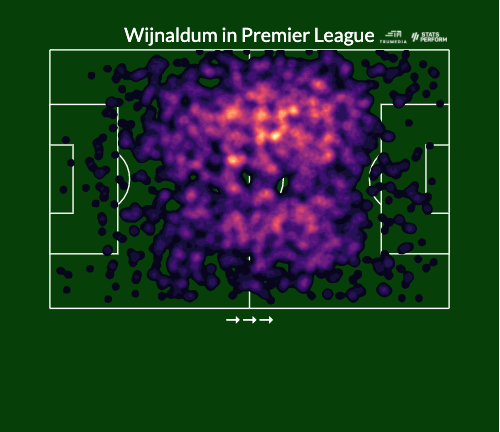How Euro 2020 Rescued the Role of the Modern Midfielder
Thank you for subscribing to No Grass in the Clouds! A reminder: we now have a Discord server for premium subscribers where we discuss all the goings on in the soccer world. For the Euros in particular, it’s a way better second-screen experience than Twitter! If that sounds appealing and you’d like to become a paying subscriber, then please follow the green button: How Euro 2020 Rescued the Role of the Modern MidfielderGini Wijnaldum, please take a bow
Someone who works in European soccer once explained to me how hard it was to scout players for speed. If you were signing a guy from a lesser league, then sure, he might look fast, but was that because he’s fast in comparison to all soccer players or just fast in comparison to the slower players he was currently playing against? You couldn’t have him run a 40 or a shuttle drill since he was employed by another team and because that kind of speed only loosely translates to soccer anyway. The perception was such a problem that he said his club would often turn to a player’s speed rating in the FIFA video game just to cross-reference what they were seeing. The same issue applies to the Euros, writ large. You can pick up on some differences between the international and club game just by watching, but when both teams are playing in a different way to what you’re used to seeing, you lose the baseline. The fans ruin everything, too. A game in front of 10,000 or 50,000 supporters is just naturally going to feel more lively and more intense than, say, Chelsea–Arsenal in a gigantic, completely empty stadium. So, how have things changed? Well, this past season was the “slowest” Premier League season on record, and so far, the Euros are even slower. This past year in England, games featured fewer sequences -- defined by Stats Perform¹ as essentially an uninterrupted possession -- than any campaign for which there’s data. The average team had 145 sequences per game; at the Euros, that number is down at 134. The speed at which teams moved the ball up the field -- measured in meters per second -- was again the lowest in recorded PL history at 1.35 m/s, and the Euros have been slightly behind that pace, too: 1.34 m/s. There’s a bit of a chicken-or-the-egg problem here: Are teams playing more slowly because they’re tired? Or are teams playing more slowly because their opponents are tired and can’t press them as much? The answer doesn’t quite matter, but pressing was down in the Premier League this year and pass-completion rates were higher than they’ve ever been. And, well, it’s been even more extreme at the Euros. Passes are being completed 84 percent of the time, compared to 81.5 percent in the Premier League. The average sequence is lasting for 10.1 seconds at the Euros, compared to 9.0 seconds in the Premier League. And the pressing rate -- PPDA, which Stats Perform defines as “the number of opposition passes allowed outside of the pressing team’s own defensive third, divided by the number of defensive actions by the pressing team outside of their own defensive third” -- is significantly dialed back, too: 14.16 at the Euros, 13.25 in the Premier League. Despite the lower rate of pressing and the much more measured possession process, teams at the Euros are still creating better chances than the average Premier League team: 0.121 expected goals per shot, compared to 0.110. It’s still a relatively tiny sample of matches -- 30 so far -- but those numbers tell a tidy little story of how international soccer is “worse”. Teams aren’t pressing much and therefore they’re not leaving as much open space in their defensive third, but somehow they’re still conceding better chances than their club counterparts. Slower and worse soccer might not sound like fun, but it’s created all kinds of new space and time for midfielders to influence the outcomes of matches. That wasn't supposed to happen anymore. One of the best things I’ve read or heard about the ongoing efforts to quantify what happens on a soccer field was Thom Lawrence’s talk at the Statsbomb Conference in 2019. It’s called “Some Things Aren't Shots: Comparative Approaches to Valuing Football”, and you can watch it right here:  In it, Lawrence delves into the world of what are commonly called “expected-possession value models” -- a framework for valuing all of the actions on a field based on how much they affect a team’s chances of scoring and conceding. A recurring problem with these models is what Lawrence called “The Valley of Meh”. It’s summed up well in this expertly designed visualization: The things that happen near your own goal have a huge effect on your opponent’s chances of scoring. The things that happen near the other team’s goal have a huge effect on your chances of scoring. And the things that happen in between those two areas ... don’t have much of an effect at all. Given all the emphasis that’s placed on midfield play in pre- and post-match analysis and given how often midfielders simply just touch the ball, that might seem heretical. But the market for players broadly agrees with the idea. Of the 50 most expensive players of all time, just five of them are players who spend most of their time in the “Valley of Meh”.² Lawrence himself doesn’t take this to be definitive proof that midfield play isn’t as valuable as we might think it is. "From the team point of view, you could look at the 'Valley of Meh' and conclude that most play in the middle of the field is actually within the margin of error, and so it doesn't matter what you do, but we know that's not really true. Every attack comes from somewhere, and it's a product of volume and quality," he told me for a piece I wrote for ESPN last year. "In terms of transfer fees, let's say you can pay to get a player who's 10 percent better than their replacement. Do you want that multiplier on lots of low-value actions in the middle of the pitch or on just a few high-value actions at the ends of the pitch? Both answers are probably valid, but it's clear the market has always taken one side of that debate." On top of that, where a player gets to touch the ball is only partially determined by the player himself. Lawrence pointed to how one successful run from an attacker might turn a possession from a 10- to 40-percent chance of ending in a goal, or how a defender might lose possession and suddenly greatly increase his opponent’s chances of scoring. “From the player point of view, we need to understand that a dribble by an attacker that beats their man to get into the box might take the exact same amount of talent as a dribble further back on the field, and that defender mistake might be relatively forgivable further up the field”, he said. “And so you've got to be very careful with how you portion out the rewards here, because players can only demonstrate their skill in the roles and opportunities available”. This applies to some of the midfielders at Euro 2020 in two clear ways. Take Gini Wijnaldum. At Liverpool, he was perhaps the least spectacular member of Jurgen Klopp’s starting XI. From a statistical perspective, he sat in the 99th-percentile for central midfielders in Europe for his pass-completion percentage, but that was really it; whether it be offensively or defensively, nothing really stood out. Klopp seemed to value him for his ability to retain the ball and his softer skills, like his positioning when the team was both in and out of possession. He filled the holes that their fantastic front three and flying fullbacks created, and he made sure to never be the one who ended a possession before it got to one of the guys who’d score or create the goals. With the Netherlands, though, he’s getting on the ball much higher up the field: His touches are scattered across the final third, while at Liverpool most of his touches were concentrated near the midfield line: Through the first three games at the Euros, he’s arguably been the player of the tournament. He’s tied with Romelu Lukaku for the lead in non-penalty goals with three. He’s averaging 3.33 shots per 90 minutes, compared to 0.95 this past season for Liverpool. Across three matches, he’s created 0.17 expected assists per 90, compared to 0.04 for Liverpool. And he’s taking four touches in the box per game, compared to 1.34 for Liverpool. It’s a perfect example of what Lawrence was talking about. At Liverpool, WIjnaldum was told to live in the Valley of Meh, but he’s been freed by Frank De Boer with Netherlands, and he’s proving he can flourish in the final-third. That’s, of course, not to say that Liverpool would’ve somehow been a better team had they let Gini cook. It’s pretty tough to argue with the club’s results over the past four seasons. Klopp seemed to make the right call in letting the front three and the fullbacks do most of the end-of-the-chain work while asking Wijnaldum to cover for them and not lose the ball. Which brings us to the second point. At the Euros, it’s a lot easier for a midfielder to escape the Valley of Meh and directly affect goal-scoring because, well, the teams they’re playing against just aren’t as good. They aren’t able to press as effectively or don’t want to, so there tends to be more time and space for midfielders to make things happen. A broad glance at the numbers suggests as much, too. Among players Stats Perform classifies as “central midfielders”, they’re doing just about everything more often than their counter-pants did this past Premier League season. In addition to Wijnaldum, Sassuolo midfielder Manuel Locatelli has been one of the breakout stars of the tournament. Marcel Sabitzer has been fantastic for Austria, as he’s been freed up to play a much more central creative role compared to the pressing and ball circulation he’d been asked to do for Julian Nagelsmann at RB Leipzig over the past couple years. After years spent winning the ball back in the Premier League, Denmark’s Pierre-Emile Hojbjerg is tied for the tournament lead in chances created with nine. He’s tied with Kevin De Bruyne, who’s played only two games but has played as part of a midfield two for much of it, rather than in a trio like he does at Manchester City. Marco Verratti has only played one match so far, and yet he created five chances without Neymar and Kylian Mbappe hogging the ball. No longer sharing the field with Bruno Fernandes, Paul Pogba looked like the One True God against Germany, and he’s completed more through balls than all but two players. And despite his struggles for Juventus, Aaron Ramsey is back at it again for Wales, currently sitting in the top 10 among all players in xG. Now, none of these players have played more than three games, and most of these players haven’t even made it that far yet. The tournament itself is still in its first stage, and there really haven’t been that many matches played. As the weaker teams start to get siphoned off, maybe the play starts to tighten up and there isn’t as much room for midfielders to make a difference. For at least the first nine days, though, Euro 2020 has been defined by fantastic, influential midfield play. It’s hard -- and might prove impossible -- to value what someone like Wijnaldum provides on a weekly basis from August through May. But you don’t need a sophisticated model or a video game to tell how much three goals in three games is worth. 1 All stats in the piece are from Stats Perform. 2 I’m not counting Arthur and Miralem Pjanic because both players moved as part of a swap deal that was more of an accounting trick for Barcelona and Juventus rather than a genuine statement on either player’s true market value. You’re on the free list for No Grass in the Clouds. For the full experience, become a paying subscriber. |
Older messages
Euro 2020: Everyone Loves ... Italy?
Thursday, June 17, 2021
Listen now (56 min) | On the latest episode of Infinite Football, Ryan, Tom, and Franco discuss all of the action at Euro 2020. How did Italy become everyone's favorite team? Will England keep the
The Actually-Not-Too-Early Euro 2020 Power Rankings
Wednesday, June 16, 2021
Are France still no. 1? What do you do with a team like Germany? And more!
It's the Euro 2020 Goalscorer Draft!
Wednesday, June 9, 2021
Listen now (65 min) | On the latest episode of Infinite Football, Ryan and Tom are joined by the original Soccer Don, the world's preeminent vegan-but-only-for-cleats, Donnie Kwak of Complex. They
Why Attempting to Predict the Winner of Euro 2020 Is a Loser's Game
Tuesday, June 8, 2021
International soccer has stumped sophisticated model-builders, economists, and NASA astrophysicists. This summer shouldn't be any different.
It's the 'No Grass in the Clouds' Euro 2020 Sale!
Monday, June 7, 2021
Come get your discounted newsletter and Discord access
You Might Also Like
There are, in fact, 3 real NBA contenders
Monday, March 10, 2025
Cleveland, Boston and OKC are heads above everyone else. ͏ ͏ ͏ ͏ ͏ ͏ ͏ ͏ ͏ ͏ ͏ ͏ ͏ ͏ ͏ ͏ ͏ ͏ ͏ ͏ ͏ ͏ ͏ ͏ ͏ ͏ ͏ ͏ ͏ ͏ ͏ ͏ ͏ ͏ ͏ ͏ ͏ ͏ ͏ ͏ ͏ ͏ ͏ ͏ ͏ ͏ ͏ ͏ ͏ ͏ ͏ ͏ ͏ ͏ ͏ ͏ ͏ ͏ ͏ ͏ ͏ ͏ ͏ ͏ ͏ ͏ ͏ ͏ ͏ ͏ ͏ ͏
Making up for that lost hour
Monday, March 10, 2025
Pressure, meet diamond
Green Light Madness 🚦
Monday, March 10, 2025
Buzzer-Beaters & Conference Champs. NFL Free-For-All. The Jokic Game. Cricket, Tennis & More...
The Warriors are a rock in my shoe I can't shake out
Friday, March 7, 2025
Explaining why I really don't like Golden State these days. ͏ ͏ ͏ ͏ ͏ ͏ ͏ ͏ ͏ ͏ ͏ ͏ ͏ ͏ ͏ ͏ ͏ ͏ ͏ ͏ ͏ ͏ ͏ ͏ ͏ ͏ ͏ ͏ ͏ ͏ ͏ ͏ ͏ ͏ ͏ ͏ ͏ ͏ ͏ ͏ ͏ ͏ ͏ ͏ ͏ ͏ ͏ ͏ ͏ ͏ ͏ ͏ ͏ ͏ ͏ ͏ ͏ ͏ ͏ ͏ ͏ ͏ ͏ ͏ ͏ ͏ ͏ ͏ ͏
Rapid-Fire Friday 🔥
Friday, March 7, 2025
NCAA Tourney Takeoff, NBA Rewind, NFL Moves, NHL Trades, Tennis, Golf & The Weekend...
You've destroyed your own luck
Wednesday, March 5, 2025
The Mavericks shortened their runway with the Luka trade. The cliff is coming up quicker than ever. ͏ ͏ ͏ ͏ ͏ ͏ ͏ ͏ ͏ ͏ ͏ ͏ ͏ ͏ ͏ ͏ ͏ ͏ ͏ ͏ ͏ ͏ ͏ ͏ ͏ ͏ ͏ ͏ ͏ ͏ ͏ ͏ ͏ ͏ ͏ ͏ ͏ ͏ ͏ ͏ ͏ ͏ ͏ ͏ ͏ ͏ ͏ ͏ ͏ ͏ ͏
Women —
Wednesday, March 5, 2025
There's no business like showbusiness
50k for The King 👑
Wednesday, March 5, 2025
LeBron's Newest Milestone. NFL Roster Moves. No. 1 Auburn Falls. Soccer, NHL, TGL & More...
There are only 4 competitive races left in the NBA season. They involve 15 teams
Tuesday, March 4, 2025
This is to say that there is still a *lot* at stake. ͏ ͏ ͏ ͏ ͏ ͏ ͏ ͏ ͏ ͏ ͏ ͏ ͏ ͏ ͏ ͏ ͏ ͏ ͏ ͏ ͏ ͏ ͏ ͏ ͏ ͏ ͏ ͏ ͏ ͏ ͏ ͏ ͏ ͏ ͏ ͏ ͏ ͏ ͏ ͏ ͏ ͏ ͏ ͏ ͏ ͏ ͏ ͏ ͏ ͏ ͏ ͏ ͏ ͏ ͏ ͏ ͏ ͏ ͏ ͏ ͏ ͏ ͏ ͏ ͏ ͏ ͏ ͏ ͏ ͏ ͏ ͏ ͏ ͏
Podcast app setup
Tuesday, March 4, 2025
Open this on your phone and click the button below: Add to podcast app





